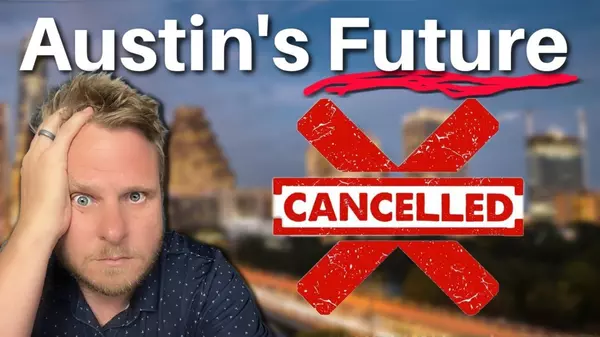A Tale of Two Markets: Austin vs. The Austin MSA - What’s Really Happening in the Housing Market?
A Tale of Two Markets: Austin vs. The Austin MSA - What’s Really Happening in the Housing Market?
If you’ve been following the Austin housing market closely, you might have heard conflicting opinions. While some market analysts, like Reventure, are predicting a market crash, others see the current spring selling season as the best in five years for American homebuyers. So, what’s really happening in Austin’s housing market? Is it still a good time to buy or sell? In this blog, we’ll take a deep dive into the current housing trends in Austin and the surrounding Austin Metropolitan Statistical Area (MSA), unpacking the differences between the two and offering insights into what buyers and sellers can expect in 2024.
What’s Going on with Austin’s Housing Market?
Let’s begin by addressing some of the confusion in the market. According to Reventure’s Nick Garelli, the housing market is currently in a state of flux, with inventory levels increasing, but so are interest rates, which are now hovering around 7%. While some areas are seeing price reductions, others remain strong, and many sellers believe they can still fetch their asking price. So, what’s driving this dichotomy?
Rising Inventory and Price Adjustments
One of the biggest trends we’re seeing in Austin right now is a rise in inventory. In fact, in March 2024, we saw a 9.3% decline in closed sales across the Austin area. However, inventory levels have shot up by 18%, suggesting that more homes are hitting the market. This increase in inventory could be a sign that the market is stabilizing, which is beneficial for homebuyers. With more options available, buyers have greater flexibility and can take their time without feeling rushed into bidding wars.
Despite the higher number of listings, prices in Austin are not skyrocketing. In fact, the median sales price in Austin dropped slightly from the previous year, hovering around $446,000. However, certain areas within the Austin MSA are seeing price reductions, especially in outer suburbs like Bastrop and Caldwell County. This tells us that while the overall market in Austin is somewhat insulated, the more peripheral areas are being impacted by rising interest rates and inventory levels.
What About Buyer Demand?
Despite the rise in interest rates, buyer demand remains strong. According to recent data, 74% of renters in the Austin area aspire to own a home someday, and 65% of them would prefer owning over renting, but many cite affordability and high mortgage rates as barriers to homeownership. However, there’s a silver lining: when mortgage rates temporarily dipped to around 6%, we saw a significant increase in buyer applications, especially from first-time homebuyers. This indicates that when rates decrease, even slightly, buyers are eager to jump into the market.
In fact, Jeremy Knight and his team are seeing an uptick in signed buyer representation agreements. They’ve closed more deals this year than in February and more than the same time last year, with many buyers securing excellent deals. So, while interest rates are still a challenge, the demand for homes in Austin remains relatively high, and buyers are continuing to make moves.
A Tale of Two Markets: Austin vs. The Austin MSA
Now, let’s break down what’s happening within the broader Austin MSA versus the city itself. The Austin Metropolitan Statistical Area (MSA) encompasses not only Austin proper but also surrounding counties, including Williamson, Hays, Travis, Bastrop, and Caldwell. While the city of Austin has experienced slight price increases, many of the suburban areas have seen larger declines, making the broader MSA a very different market.
Austin City Market: Insulated, But Not Immune
In Austin proper, the median sales price has increased by 5.5% year-over-year, making it one of the more resilient markets in the MSA. Despite this, closed sales in the city are still down 9.3%, showing that even Austin is not immune to the effects of higher interest rates and affordability concerns. However, Austin is somewhat insulated from these pressures due to its higher demand, desirable location, and limited available land for new development. In fact, 60% of homes sold in Austin last month were priced under $500,000, a testament to the city’s competitive pricing.
The Suburbs: More Inventory, More Affordability
In contrast, the surrounding suburbs have seen more significant fluctuations. For example:
-
Williamson County saw a slight decline in prices, with a median of $418,000. However, pending sales were up, suggesting that buyers are still interested in suburban homes.
-
Travis County experienced a 5% increase in median prices to $529,000, but closed sales were down slightly, and the pending sales showed a mixed picture.
-
Hayes County, just south of Austin, saw a more modest 2% increase in prices with a median of $390,000.
-
Bastrop and Caldwell Counties saw larger declines, with Bastrop’s median price down 6.3% to $351,000.
In these areas, new construction homes are still in high demand, and the ability to secure a new build for a lower price than a resale property is one of the driving factors behind suburban growth. Buyers looking for more space or affordable options are increasingly opting for new developments in the suburbs rather than paying premium prices in the city.
Renters’ Growing Desire to Buy
Another interesting trend we’re seeing is that renters are increasingly looking to buy. In fact, 74% of renters aspire to own a home, according to recent reports. The biggest hurdles for renters looking to buy are affordability and the high cost of mortgage rates. With median rents in the Austin area staying high (around $2,450 in the city itself), renters are feeling the pressure and are looking for ways to transition into homeownership.
As the market becomes more balanced with increasing inventory, potential buyers are starting to see the value in investing in a home rather than continuing to rent. Many of them are simply waiting for rates to drop or for prices to stabilize, but there is no doubt that the desire to own is strong among renters, and this could fuel demand for homes once conditions improve.
What Does This Mean for Buyers and Sellers?
Is It a Good Time to Buy in Austin?
While the Austin market is showing signs of stabilization, with prices holding steady and inventory rising, it may still be a good time to buy—especially if you’re looking to purchase outside of Austin’s core areas. The increased inventory means more options for buyers, and with interest rates dipping slightly, more buyers are entering the market.
The suburbs, particularly areas like Williamson and Hays counties, offer more affordable options with greater inventory. Plus, new construction homes continue to be a hot commodity, providing buyers with a fresh, modern living space at a competitive price.
However, buyers should be cautious of fluctuating mortgage rates and remain vigilant in negotiating good deals, particularly with sellers who may still have unrealistic expectations about achieving high asking prices.
Is It a Good Time to Sell in Austin?
For sellers in Austin, the market is still favorable but less competitive than it was during the pandemic boom. The increased inventory and higher interest rates have made it more challenging to secure above-list offers. Sellers who have listed their homes for higher-than-market prices may need to adjust their expectations, as many homes are now selling for less than the asking price.
Sellers in the suburbs may face a different challenge, with more inventory coming onto the market and fewer buyers willing to pay premium prices. However, those with new construction properties or homes in highly desirable neighborhoods may still find success.
Conclusion: Navigating Austin’s Housing Market
In conclusion, the Austin housing market is showing signs of both stability and fluctuation. While the city itself remains relatively insulated with slight price increases, the surrounding suburbs are seeing more varied trends, with some areas experiencing price reductions and others holding steady.
For buyers, it’s a great time to take advantage of the increased inventory and potentially negotiate better deals, especially in the suburbs. For sellers, the market is still favorable, but price adjustments may be necessary to attract serious buyers.
Ultimately, the housing market in Austin and the surrounding MSA is in a state of transition, with both challenges and opportunities for those looking to buy or sell. If you're considering making a move in the Austin area, it’s important to stay informed about the latest trends and work with an experienced realtor who can help guide you through the complexities of the market.
Reach out today to discuss your options, whether you're buying or selling, and let us help you navigate the evolving Austin housing market.
Categories
Recent Posts












